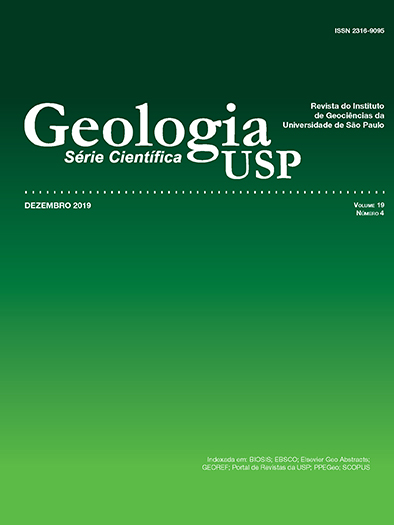Hiperpicnites (Inundites) as reservoir analogs: an example in the Triassic Gondwanic deposits of Arroio Moirão Graben, Rio Grande do Sul
DOI:
https://doi.org/10.11606/issn.2316-9095.v19-143145Keywords:
Paraná basin, Santa Maria Formation, Candelária sequence, Extrabasinal turbiditesAbstract
Sandstones associated with episodic flooding models, such as inundites from hyperpicnal flows in shallow water bodies, can be hydrocarbon reservoirs. However, there are few studies to understand the architecture and heterogeneity of these models, resulting in difficulties to explore and exploit these reservoirs. The current work aimed to analyze Triassic strata from the Paraná Basin belonging to the Santa Maria Formation, which occur as isolated fragments over the Sul-Rio-Grandense Shield in the region of Arroio Moirão Graben (RS). Thus, a comparative study of flood models was made, as a methodology for data collection, systematic mapping, facies heterogeneity analysis and sequence stratigraphy were used, including columnar profiles survey, identification of facies associations and sequences, and key surfaces. Secondarily, some petrographic analyses were performed. It was possible to define the main deposits of sandstones, in which tabular geometry, poorly selected grains and clay matrix predominate. Five ascending granodecrescent depositional cycles were distinguished, limited at the base and the top by erosive surfaces, which mark recurrent heterogeneities. Reservoir facies are subarkoses, with clay matrix aggregates of kaolinite, intergranular porosity and shrinkage. Potential reservoir facies formed by coarse to conglomerate sandstones with tangential and planar bed cross stratifications were identified. Data integration resulted in the elaboration of a model of lateral and vertical facies variation of lake hyperpicnites, as a potential analogous model of compartmentalized-type reservoir. These results allow the prospection of other sandy deposits from this stratigraphic unit of the Paraná Basin, in order to regionally evaluate the reservoir analogue.
Downloads
Downloads
Published
Issue
Section
License
Authors who publish in this journal shall comply with the following terms:
- Authors keep their copyright and grant to Geologia USP: Série Científica the right of first publication, with the paper under the Creative Commons BY-NC-SA license (summary of the license: https://creativecommons.org/licenses/by-nc-sa/4.0 | full text of the license: https://creativecommons.org/licenses/by-nc-sa/4.0/legalcode) that allows the non-commercial sharing of the paper and granting the proper copyrights of the first publication in this journal.
- Authors are authorized to take additional contracts separately, for non-exclusive distribution of the version of the paper published in this journal (publish in institutional repository or as a book chapter), granting the proper copyrights of first publication in this journal.
- Authors are allowed and encouraged to publish and distribute their paper online (in institutional repositories or their personal page) at any point before or during the editorial process, since this can generate productive changes as well as increase the impact and citation of the published paper (See The effect of Open Access and downloads on citation impact).





